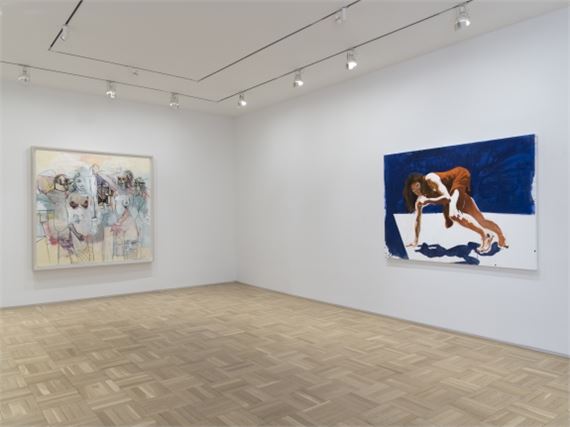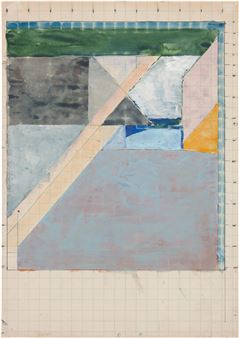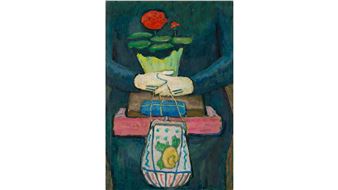Faces and Figures
Skarstedt is pleased to present Faces and Figures, a group exhibition of paintings, sculptures, and photographs demonstrating the many ways in which the components of artist, model, and representation have been configured and reconfigured from the mid-twentieth-century to present.
Gazing upward, the slender Eli Lotar (photographer and frequent sitter for Alberto Giacometti) is depicted in the famed sculptorÔÇÖs final work, Buste dÔÇÖhomme assis (Lotar III). A sculptor of faces, figures, and gestures, Giacometti typifies this tripartite of artist, model and representation within the posthumously cast bronze. As if a kneeling Egyptian pharaoh, the severe and somber Lotar sits resolutely, the once malleable pinches and chasms of clay articulating the artistÔÇÖs last vision.
A fascination with flesh and figure, de Kooning, strongly influenced by Giacometti ÔÇô likely having seen the sculptorÔÇÖs work as early as 1948 in the Pierre Matisse Gallery in New York ÔÇô incorporated the same modes of perspectival shifts, space and texture. In her analysis of de Kooning in relation to Giacometti, art historian Rosalind Krauss writes, ÔÇťDe KooningÔÇÖs own Head #3 (1973), with its rugged surface and incompatible points of view echoes what Sartre had written about the presence of the sculptor as the ambient point of viewÔÇŁ (Krauss, Willem de Kooning Nonstop: Cherchez la Femme, 2016, p. 52). Krauss referencing Jean-Paul SartreÔÇÖs essay on this same 1948 exhibition for Giacometti, connects not only the two artistÔÇÖs centrality on the human figure, but even more so in the way they are represented spatially and conceptually.
This spatial evaluation of both faces and figures was masterfully upturned by Picasso ÔÇô Le Peintre, 6 February 68 ┬şchampions the spirit of a musketeer, utilizing the model of a 17th century cavalier to transform himself into this image of a valiant painter. Picasso engages simultaneously with the past and present and embodies all three components of artist, model, and representation, stating, ÔÇťmovement of the painting, the dramatic effort from one vision to the next, even if the effort is not carried through. I have reached the stage where the movement of my thought interests me more than the thought itselfÔÇŁ (Picasso in K. Gallwitz, Picasso Laureatus, 1971, p. 166).

Recommended for you
Skarstedt is pleased to present Faces and Figures, a group exhibition of paintings, sculptures, and photographs demonstrating the many ways in which the components of artist, model, and representation have been configured and reconfigured from the mid-twentieth-century to present.
Gazing upward, the slender Eli Lotar (photographer and frequent sitter for Alberto Giacometti) is depicted in the famed sculptorÔÇÖs final work, Buste dÔÇÖhomme assis (Lotar III). A sculptor of faces, figures, and gestures, Giacometti typifies this tripartite of artist, model and representation within the posthumously cast bronze. As if a kneeling Egyptian pharaoh, the severe and somber Lotar sits resolutely, the once malleable pinches and chasms of clay articulating the artistÔÇÖs last vision.
A fascination with flesh and figure, de Kooning, strongly influenced by Giacometti ÔÇô likely having seen the sculptorÔÇÖs work as early as 1948 in the Pierre Matisse Gallery in New York ÔÇô incorporated the same modes of perspectival shifts, space and texture. In her analysis of de Kooning in relation to Giacometti, art historian Rosalind Krauss writes, ÔÇťDe KooningÔÇÖs own Head #3 (1973), with its rugged surface and incompatible points of view echoes what Sartre had written about the presence of the sculptor as the ambient point of viewÔÇŁ (Krauss, Willem de Kooning Nonstop: Cherchez la Femme, 2016, p. 52). Krauss referencing Jean-Paul SartreÔÇÖs essay on this same 1948 exhibition for Giacometti, connects not only the two artistÔÇÖs centrality on the human figure, but even more so in the way they are represented spatially and conceptually.
This spatial evaluation of both faces and figures was masterfully upturned by Picasso ÔÇô Le Peintre, 6 February 68 ┬şchampions the spirit of a musketeer, utilizing the model of a 17th century cavalier to transform himself into this image of a valiant painter. Picasso engages simultaneously with the past and present and embodies all three components of artist, model, and representation, stating, ÔÇťmovement of the painting, the dramatic effort from one vision to the next, even if the effort is not carried through. I have reached the stage where the movement of my thought interests me more than the thought itselfÔÇŁ (Picasso in K. Gallwitz, Picasso Laureatus, 1971, p. 166).
Contact details

Related articles
With much of America enjoying the beginning of spring this month, March in New York can feel like winterÔÇÖs overtime. Beat the ÔÇťblahsÔÇŁ by visiting these four remarkableÔÇôand very differentÔÇô shows, one for each weekend of the month.
When a major gallery such as Skarstedt puts on a show that is meant to "demonstrate the many ways in which the components of artist, model, and representation have been configured and reconfigured from the mid-twentieth-century to present.
Five of the ten portrait paintings in this Francis Bacon exhibition, ÔÇťFaces & Figures,ÔÇŁ were studies, indicating that they may have been works in progress.

 ARTISTS
ARTISTS














